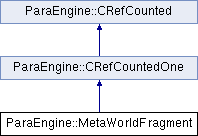A MetaWorldFragment is the basic building block of the world. More...
#include <MetaWorldFragment.h>

Public Types | |
| typedef std::vector< MetaWorldFragment * > | WfList |
| typedef std::vector< MetaWorldFragment * >::iterator | WfIter |
| typedef std::vector< MetaWorldFragment * >::const_iterator | WfConstIter |
Public Member Functions | |
| MetaWorldFragment (const Vector3 &position, int ylevel=0) | |
| Creates new MetaWorldFragment, it will only create IsoSuface and grid on demand. | |
| void | addMetaObject (MetaObjectPtr mo) |
| Adds MetaObject to mObjs, and to mMoDataGrid. | |
| void | update (IsoSurfaceBuilder *builder) |
| Updates IsoSurface. More... | |
| int | getNumMetaObjects () |
| const CShapeAABB | getAABB () |
| const Vector3 | getPosition () |
| const bool | empty () |
| IsoSurfaceRenderable * | getIsoSurface () |
| int | getYLevel () |
| bool | IsNeedUpdate () |
| it will only update when needed by draw function call. | |
| void | SetNeedUpdate (bool bNeedUpdate=true) |
 Public Member Functions inherited from ParaEngine::CRefCounted Public Member Functions inherited from ParaEngine::CRefCounted | |
| void | addref () const |
| add reference count of the object. More... | |
| bool | delref () const |
| decrease reference count of the object. More... | |
| int | GetRefCount () const |
| get the reference count | |
| virtual int | Release () |
| CRefCounted * | AddToAutoReleasePool () |
| addref and releases the ownership sometime soon automatically (usually at the end of the current frame). More... | |
Protected Member Functions | |
| void | addToWfList (MetaWorldFragment *wf) |
Protected Attributes | |
| IsoSurfaceRenderable * | mSurf |
| Vector3 | mPosition |
| CShapeAABB | mAabb |
| std::vector< MetaObjectPtr > | mObjs |
| std::vector< MetaWorldFragment * > | mAdjacentFragments |
| TODO: currently no merging is supported for adjacent fragments. | |
| int | mYLevel |
| position in y, counted in tile-sizes. More... | |
| bool | m_bNeedUpdate |
| whether the grid is modified and needs update in the next draw call. More... | |
 Protected Attributes inherited from ParaEngine::CRefCounted Protected Attributes inherited from ParaEngine::CRefCounted | |
| int | m_refcount |
Static Protected Attributes | |
| static float | mGridScale = 0 |
| static float | mSize = 0 |
| static std::string | mMaterialName = "" |
Detailed Description
A MetaWorldFragment is the basic building block of the world.
it has its own IsoSurface which is used for rendering. When created, an IsoSurface should be created..The MetaWorldFragment will also contain portals to other MetaWorldFragments for visibility culling (todo).
Member Function Documentation
§ update()
| void MetaWorldFragment::update | ( | IsoSurfaceBuilder * | builder | ) |
Updates IsoSurface.
Zero data grid, then add the fields of objects to it.
Member Data Documentation
§ m_bNeedUpdate
|
protected |
whether the grid is modified and needs update in the next draw call.
§ mYLevel
|
protected |
position in y, counted in tile-sizes.
this value is only useful when we are trying to manage a pool of metaworldfragments nearby according to their Y level. so that we can group by height. This is usefully when doing voxel based terrain.
The documentation for this class was generated from the following files:
- Client/trunk/ParaEngineClient/VoxelMesh/MetaWorldFragment.h
- Client/trunk/ParaEngineClient/VoxelMesh/MetaWorldFragment.cpp
 1.8.12
1.8.12